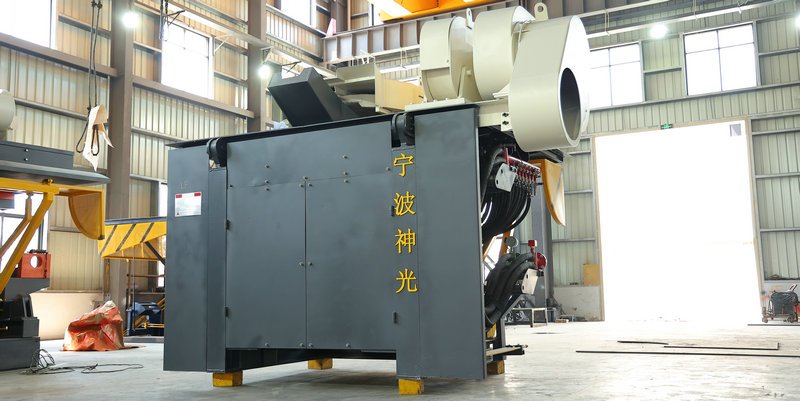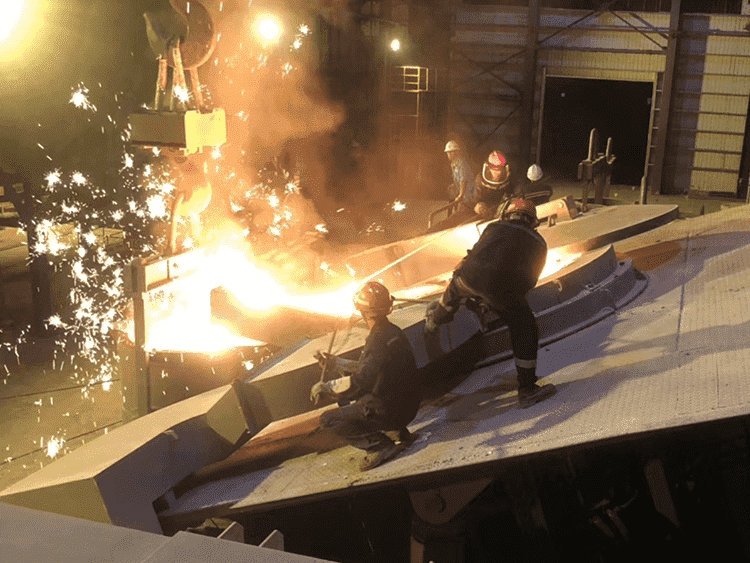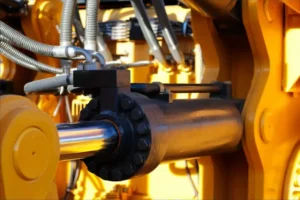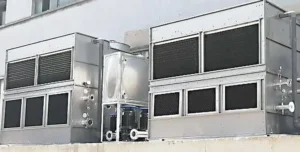Coreless type induction furnace is an industrial equipment used for heating metals. It is mainly used for melting metals, อัลลอยด์, and other conductive materials. Unlike traditional electric arc furnaces or resistance furnaces, coreless induction furnaces do not require the use of fixed electrodes or mandrels to deliver current, but work through the principle of induction heating.
Coreless induction furnace working principle
- The external coil generates alternating current: The core of the เตาเหนี่ยวนำแบบไม่มีแกน is an external coil, also called an induction coil. This coil is connected to a power source and passes an alternating current (usually a high-frequency current). When current passes through the external coil, it creates a strong alternating magnetic field.
- Inner coil with metal placed inside it: There is usually an inner coil around the outer coil, the inner coil is the container used to hold the metal or alloy to be heated. The metal is usually placed in the center of the inner coil to receive maximum induction heating.
- Magnetic field-induced eddy currents: The alternating magnetic field generated by the outer coil penetrates the inner coil and the metal within it. According to Faraday’s law of electromagnetic induction, when a metallic material is exposed to this alternating magnetic field, it induces electric currents, which are often called eddy currents. Eddy currents are generated because the electrons in the metal are affected by the magnetic field, which causes the electrons to move inside the metal and generate heat.
- Heating the metal: The eddy current created flows in the metal, and this current generates heat through the resistance. Because eddy currents are formed throughout the metal, the metal heats up evenly, resulting in a uniform heating process.
- Metal melting and processing: By continuously passing an electric current, the metal gradually heats up and eventually melts. Once the metal reaches the desired temperature, it can undergo further processing such as casting, การคัดเลือกนักแสดง, การรักษาความร้อน, or other industrial applications.

Advantages and Disadvantages of Coreless Furnace
advantage:
- Efficient heating: The coreless type induction furnace can efficiently convert electrical energy into heat energy with almost no energy waste, so it is more energy-saving than traditional heating methods.
- ให้ความร้อนอย่างรวดเร็ว: The induction heating process is very fast, and the metal material can reach the required temperature almost instantly, thus improving production efficiency.
- เครื่องทำความร้อนสม่ำเสมอ: Induction heating generates eddy currents inside the metal, causing the metal to heat evenly, avoiding heat differences and helping to produce uniform products.
- การควบคุมอุณหภูมิที่แม่นยำ: Induction furnaces allow very precise control of heating temperature to meet specific process requirements and ensure product quality.
- Reduce gas emissions: Compared with combustion furnaces, coreless induction furnaces generally do not produce waste gas or waste residue, thus reducing environmental pollution.
- Less maintenance required: Induction furnaces have no parts in direct contact with the metal, such as electrodes or mandrels, so they generally require less maintenance.
- Reusable furnace binding materials: Furnace binding materials can be reused multiple times, reducing material waste.
ข้อเสีย:
- High starting cost: Coreless induction furnaces are relatively expensive to purchase and install, which can be a burden on small businesses and start-ups.
- Can only heat conductive materials: Induction furnaces can only be used to heat conductive materials and are ineffective for non-conductive materials. This limits its application scope.
- Cooling system is required: The induction furnace will generate a lot of heat after long-term operation, and a cooling system is required to maintain the operating temperature.
- High power requirements: Induction furnaces typically require high-power power supplies, which can result in higher power costs.
- Complex operation: Operating and maintaining an induction furnace requires professional knowledge because it involves electromagnetic fields and high-temperature operations, and requires qualified operators.
พื้นที่ใช้งาน
- Metal smelting and casting: Coreless type induction furnaces are used to melt and cast various metals and alloys, such as iron, เหล็ก, ทองแดง, อลูมิเนียม, tin, lead, ฯลฯ. These furnaces are widely used in the foundry industry to produce automotive parts, ท่อ, วาล์ว, kitchenware, tools, วัสดุก่อสร้าง, และอื่น ๆ.
- การรักษาความร้อน: It is used to perform metal heat treatment, such as quenching, tempering and annealing, to change the properties and hardness of the metal. This is useful when making parts with high strength and good wear resistance.
- Metal processing: ในด้านการแปรรูปโลหะ, coreless type induction furnaces are used to heat metal rods, tubes or plates for bending, กลิ้ง, extrusion, thermoforming and other operations.
- Recycling metal: used to recycle scrap metal, melt the scrap metal and reuse it in new production processes. This helps reduce resource waste and environmental impact.
- Laboratory and Research: In laboratories and research institutions, coreless type induction furnaces are used to conduct a variety of experiments, including material property testing, alloy development, and metal research.
- Electronics and Semiconductor Manufacturing: Coreless type induction furnaces are used in the electronics and semiconductor industry for heating and melting of metals such as indium, tin, lead, ฯลฯ. for manufacturing electronic components.
- Jewelry and gemstone manufacturing: In jewelry and gemstone manufacturing, it is used to heat gold, silver and other gemstone-related materials for casting and making jewelry.
- Aerospace and Defense: Coreless type induction furnaces are used in the aerospace and defense industry to manufacture components and materials such as engine parts, missile casings, aircraft structures, ฯลฯ.
- Food Processing: It can also be used in certain applications in the food industry, such as heating and keeping food or liquids warm.

How to Melt Metal
1. การตระเตรียม: อันดับแรก, prepare the metal to be melted. This may be scrap metal, metal alloys or fresh metal materials. Metal is usually supplied in blocks, billets, ingots or other shapes.
2. Place the metal: Place the metal to be melted in the internal coil of the coreless type induction furnace. This inner coil is located in the center of the outer coil, and the metal should be distributed as evenly as possible within the inner coil.
3. Apply current: Connect the external coil of the coreless type induction furnace to the power supply, and then apply alternating current. This current will generate a strong alternating magnetic field in the external coil.
4. Induced Eddy Currents: As metal is placed in a magnetic field, it induces eddy currents. These eddy currents flow inside the metal, generating heat from electrical resistance.
5. Heating the metal: The metal begins to heat, and the heat generated by the internal eddy current gradually increases the temperature of the metal. The electrons inside the metal move due to the magnetic field, which generates heat.
6. Melting Metal: As the temperature of the metal increases, it eventually reaches its melting point and begins to melt. Once the metal is completely melted, it can be used in a variety of castings, casts, or other applications.
7. Maintain temperature: Coreless induction furnaces can maintain the temperature of metal by controlling the size and frequency of external current. This allows the metal to be kept at a specific temperature as needed.
8. Unloading: Once the metal is completely melted and processed, it can be unloaded from the induction furnace to continue with subsequent production steps.








